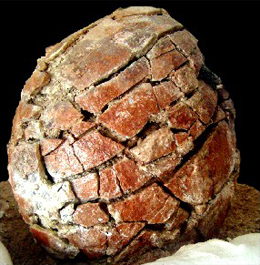Research Abstract
アルゼンチンで新たに見つかった、白亜紀の熱水環境で新竜脚類恐竜が繁殖していたことを示す営巣地跡
A new Argentinean nesting site showing neosauropod dinosaur reproduction in a Cretaceous hydrothermal environment
2010年6月29日 Nature Communications 1 : 32 doi: 10.1038/ncomms1031

写真はサナガスタ地質公園で見つかった、新竜脚類の標準的な21センチメートルの卵。これらの卵は非鳥類恐竜の卵として最大級のものである。白亜紀の熱水環境の特徴をもつ1~3メートルの厚さの地層に、ひとかえり分ごとの卵の集まりがあちこちにある形で復元された。
Credit: Gerald Grellet-Tinner/Lucas Fiorelli
白亜紀後期の竜脚類の集団営巣地跡は、ここ数十年の間にほぼすべての大陸で合わせて数か所見つかっているが、これらの特定の場所が選ばれた基盤となる要因 を突き止めようとした研究はこれまでなかった。本論文では、アルゼンチンのラリオハ州サナガスタにある白亜紀の熱水系地層の発掘場所で、竜脚類の一群が意 図的に繰り返し営巣していたことを示す初めての決定的証拠を提示する。この新しい集団営巣地跡の発見は、営巣地に対する長期の忠実性が存在したことや、産 みつけられた卵群と、それらの孵化に好都合だった特殊な熱水環境との間に、生物学的な関連性があったことを示している。80組の卵群の堆積学的および地球 化学的解析と、これらの大きな卵の殻が厚いことから、このサナガスタの竜脚類は明らかに土壌水分と熱放射を利用して卵を温め、孵化させていたことが立証さ れる。この孵化方法は、鳥類のトンガツカツクリ(Megapodius pritchardii)など、ごく少数の現生種のものとよく似ている。トンガツカツクリは、営巣地の火山活動で温まった地面に巣穴を掘って、そこに卵を産むことが知られている。
- フィールド博物館およびジャーニー博物館(米)
- CRILAR-CONICET(アルゼンチン)
Although several late Cretaceous sauropod colonial nesting sites have been discovered nearly on every continent during the last few decades, no studies these specific sites. Here, we report the first definitive evidence of a group of sauropods that nested repetitively and purposely at a Cretaceous hydrothermal site at Sanagasta, La Rioja Province, Argentina. The discovery of this new colonial nesting locality shows nest fidelity over a long time, and a symbiotic relationship between egg clutches and a peculiar hydrothermal environment that favoured their incubation. Sedimentary and geochemical analyses of 80 clutches and their large eggs with thick eggshells substantiate that the Sanagasta sauropods were specifically using the soil moisture and thermoradiance to incubate their eggs, similar to a few extant species, namely, the megapode, Megapodius pritchardii, which is known to lay its egg clutches in burrows at volcanically heated nesting grounds.

